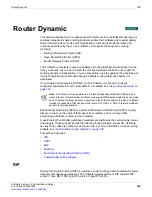
Router Dynamic
RIP
FortiGate Version 4.0 Administration Guide
01-400-89802-20090424
289
•
Router Dynamic
This section explains how to configure dynamic protocols to route traffic through large or
complex networks. Dynamic routing protocols enable the FortiGate unit to automatically
share information about routes with neighboring routers and learn about routes and
networks advertised by them. The FortiGate unit supports these dynamic routing
protocols:
•
Routing Information Protocol (RIP)
•
Open Shortest Path First (OSPF)
•
Border Gateway Protocol (BGP).
The FortiGate unit selects routes and updates its routing table dynamically based on the
rules you specify. Given a set of rules, the unit can determine the best route or path for
sending packets to a destination. You can also define rules to suppress the advertising of
routes to neighboring routers and change FortiGate routing information before it is
advertised.
If you enable virtual domains (VDOMs) on the FortiGate unit, dynamic routing is
configured separately for each virtual domain. For details, see
Bi-Directional Forwarding (BFD) is a protocol that works with BGP and OSPF to quickly
discover routers on the network that cannot be contacted, and to re-route traffic
accordingly until those routers can be contacted.
A useful part of the FortiOS web-based management interface is the customizable menus
and widgets. These widgets include the following routing widgets: access list, distribute
list, key chain, offset list, prefix list, and route map. For more information on these routing
widgets, see
“Customizable routing widgets” on page 309
This section describes:
•
•
•
•
•
Bi-directional Forwarding Detection (BFD)
•
RIP
Routing Information Protocol (RIP) is a distance-vector routing protocol intended for small,
relatively homogeneous networks. The FortiGate implementation of RIP supports RIP
version 1 (see RFC 1058) and RIP version 2 (see RFC 2453).
Note:
A FortiGate unit can operate as a Protocol Independent Multicast (PIM) version 2
router in the root virtual domain. FortiGate units support PIM sparse mode and dense mode
and can service multicast servers or receivers on the network segment to which a FortiGate
interface is connected. PIM can use static routes, RIP, OSPF, or BGP to forward multicast
packets to their destinations.
Summary of Contents for Gate 60D
Page 705: ...www fortinet com...
Page 706: ...www fortinet com...




































